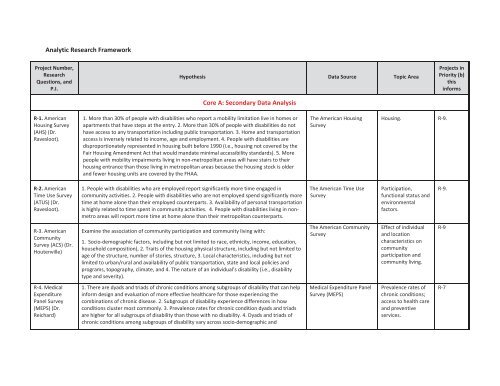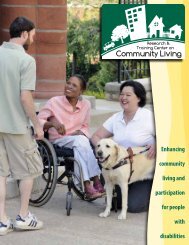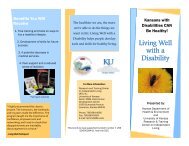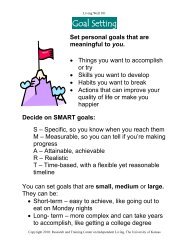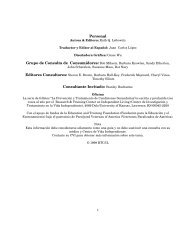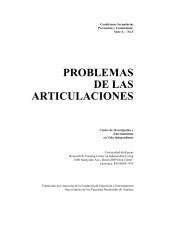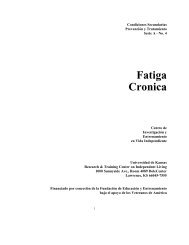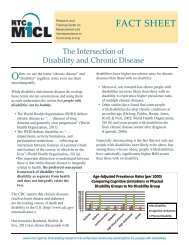Analytic Research Framework Core A: Secondary Data Analysis
Analytic Research Framework Core A: Secondary Data Analysis
Analytic Research Framework Core A: Secondary Data Analysis
You also want an ePaper? Increase the reach of your titles
YUMPU automatically turns print PDFs into web optimized ePapers that Google loves.
<strong>Analytic</strong><strong>Research</strong><strong>Framework</strong><br />
ProjectNumber,<br />
<strong>Research</strong><br />
Questions,and<br />
P.I.<br />
<br />
Hypothesis<br />
<br />
<strong>Data</strong>Source<br />
<br />
TopicArea<br />
Projectsin<br />
Priority(b)<br />
this<br />
informs<br />
<strong>Core</strong>A:<strong>Secondary</strong><strong>Data</strong><strong>Analysis</strong><br />
R1.American<br />
HousingSurvey<br />
(AHS)(Dr.<br />
Ravesloot).<br />
1.Morethan30%ofpeoplewithdisabilitieswhoreportamobilitylimitationliveinhomesor<br />
apartmentsthathavestepsattheentry.2.Morethan30%ofpeoplewithdisabilitiesdonot<br />
haveaccesstoanytransportationincludingpublictransportation.3.Homeandtransportation<br />
accessisinverselyrelatedtoincome,ageandemployment.4.Peoplewithdisabilitiesare<br />
disproportionatelyrepresentedinhousingbuiltbefore1990(i.e.,housingnotcoveredbythe<br />
FairHousingAmendmentActthatwouldmandateminimalaccessibilitystandards).5.More<br />
peoplewithmobilityimpairmentslivinginnonmetropolitanareaswillhavestairstotheir<br />
housingentrancethanthoselivinginmetropolitanareasbecausethehousingstockisolder<br />
andfewerhousingunitsarecoveredbytheFHAA.<br />
TheAmericanHousing<br />
Survey<br />
Housing.<br />
R9.<br />
R2.American<br />
TimeUseSurvey<br />
(ATUS)(Dr.<br />
Ravesloot).<br />
1.Peoplewithdisabilitieswhoareemployedreportsignificantlymoretimeengagedin<br />
communityactivities.2.Peoplewithdisabilitieswhoarenotemployedspendsignificantlymore<br />
timeathomealonethantheiremployedcounterparts.3.Availabilityofpersonaltransportation<br />
ishighlyrelatedtotimespentincommunityactivities.4.Peoplewithdisabilitieslivinginnon<br />
metroareaswillreportmoretimeathomealonethantheirmetropolitancounterparts.<br />
TheAmericanTimeUse<br />
Survey<br />
<br />
Participation,<br />
functionalstatusand<br />
environmental<br />
factors.<br />
R9.<br />
R3.American<br />
Community<br />
Survey(ACS)(Dr.<br />
Houtenville)<br />
Examinetheassociationofcommunityparticipationandcommunitylivingwith:<br />
1. Sociodemographicfactors,includingbutnotlimitedtorace,ethnicity,income,education,<br />
householdcomposition),2.Traitsofthehousingphysicalstructure,includingbutnotlimitedto<br />
ageofthestructure,numberofstories,structure,3.Localcharacteristics,includingbutnot<br />
limitedtourban/ruralandavailabilityofpublictransportation,stateandlocalpoliciesand<br />
programs,topography,climate,and4.Thenatureofanindividual’sdisability(i.e.,disability<br />
typeandseverity).<br />
TheAmericanCommunity<br />
Survey<br />
Effectofindividual<br />
andlocation<br />
characteristicson<br />
community<br />
participationand<br />
communityliving.<br />
R9<br />
R4.Medical<br />
Expenditure<br />
PanelSurvey<br />
(MEPS)(Dr.<br />
Reichard)<br />
1.Therearedyadsandtriadsofchronicconditionsamongsubgroupsofdisabilitythatcanhelp<br />
informdesignandevaluationofmoreeffectivehealthcareforthoseexperiencingthe<br />
combinationsofchronicdisease.2.Subgroupsofdisabilityexperiencedifferencesinhow<br />
conditionsclustermostcommonly.3.Prevalenceratesforchronicconditiondyadsandtriads<br />
arehigherforallsubgroupsofdisabilitythanthosewithnodisability.4.Dyadsandtriadsof<br />
chronicconditionsamongsubgroupsofdisabilityvaryacrosssociodemographicand<br />
MedicalExpenditurePanel<br />
Survey(MEPS)<br />
Prevalenceratesof<br />
chronicconditions;<br />
accesstohealthcare<br />
andpreventive<br />
services.<br />
R7
ProjectNumber,<br />
<strong>Research</strong><br />
Questions,and<br />
P.I.<br />
<br />
Hypothesis<br />
<br />
<strong>Data</strong>Source<br />
<br />
TopicArea<br />
Projectsin<br />
Priority(b)<br />
this<br />
informs<br />
R4.Medical<br />
Expenditure<br />
PanelSurvey<br />
(MEPS)(Dr.<br />
Reichard<br />
(continued)<br />
geographicfactors.5.Dyadsandtriadsofchronicconditionsamongsubgroupsofdisability<br />
reportdifferentialaccesstohealthcareandpreventiveservices.6.Dyadsandtriadsofchronic<br />
conditionsamongsubgroupsofdisabilityreportdifferentialhealthstatus.7.Themultivariate<br />
relationshipsbetweenpredisposingcharacteristics,thehealthcaresystem,external<br />
environment,enablingcharacteristics,need,andrealizedaccessaremoderatedbydisability<br />
typeandclusters(dyadsandtriads)ofchronicconditions.8.Themultivariaterelationships<br />
betweenpredisposingcharacteristics,thehealthcaresystem,externalenvironment,enabling<br />
characteristics,need,realizedaccessandhealthstatusaremoderatedbydisabilitytypeand<br />
clusters(dyadsandtriads)ofchronicconditions.<br />
<br />
R5Vocational<br />
Rehabilitation<br />
(VR)(Dr.<br />
Balcazar)<br />
1.Whichdemographicfactors(e.g.,race,gender,age,disabilitytype,education,accessto<br />
reliabletransportation,etc.)influencesuccessfulemployment/rehabilitationoutcomesamong<br />
VRconsumersresidingininstitutions,transferringoutorresidinginthecommunity?Which<br />
demographicfactorsarerelatedtofailuretoattainrehabilitationgoals?2.Whichcaselevel<br />
characteristics(e.g.,referralsource,sourceofincomeattimeofentry,consumer’sincome<br />
level,etc.)influencesuccessfulattainmentofVRgoalsamongconsumersresidingin<br />
institutions,transferringoutorresidinginthecommunity?Whichcaselevelcharacteristicsare<br />
relatedtofailuretoattainrehabilitationgoals?3.WhichVRlevelvariables(e.g.,22typesofVR<br />
services,numberofservicesreceived,serviceprovider,caseexpenditures,etc.)influence<br />
positiveattainmentofVRgoalsamongconsumersresidingininstitutions,transferringoutor<br />
residinginthecommunity?WhichVRlevelvariablesarerelatedtofailuretoattain<br />
rehabilitationgoals?<br />
VirtualCaseManagement<br />
Files<br />
Rehabilitation.<br />
R9<br />
R11<br />
R6.SPARC/<strong>Core</strong><br />
(Dr.Gray/Dr.<br />
Dashner)<br />
Individualswithmobilityimpairmentswhousemobilityenhancingdevices,thosewhohave<br />
visualimpairmentsandthosewhoarehardofhearingwilldifferinthe:<br />
1.Frequencyofvisitingcommunitysites;2.Evaluationofcommunitysitevisits;3.Receptionat<br />
thecommunitysitestheyvisit;4.Amountofpersonalassistancetheyusetovisitcommunity<br />
sites;5.Reasonsfornotvisitingcommunitysites;6.Demographicfactorsgeographicfactors.<br />
<strong>Data</strong>setcollectedusing<br />
webbasedsurveysof<br />
peoplewithdisabilities,<br />
SPARCandCORE,in2007<br />
2010<br />
Factorsinfluencing<br />
communitylivingfor<br />
peoplewith<br />
disabilities.<br />
R8&R10<br />
<strong>Core</strong>B:Interventions<br />
<br />
Hypothesis<br />
InterventionDesign<br />
<br />
TopicArea<br />
<br />
PAR<br />
Fidelityof<br />
implementation<br />
R7.Health<br />
Navigator(Dr.<br />
Reichard)<br />
1.Afterreceivinghealthnavigatortraining,casemanagerswill<br />
valuewhattheyhavelearned.2.Afterreceivinghealthnavigator<br />
training,casemanagerswillincorporatewhattheyhavelearned<br />
Modifiedpretest<br />
posttestcontrol<br />
groupdesign.<br />
Healthnavigation<br />
Toensurethatthegoals,<br />
proceduresand<br />
outcomesof<br />
Tobedeveloped,will<br />
includeaself<br />
monitoringfidelity
Hypothesis<br />
<br />
InterventionDesign<br />
<br />
TopicArea<br />
<br />
PAR<br />
Fidelityof<br />
implementation<br />
R7.Health<br />
Navigator(Dr.<br />
Reichard)<br />
(continued)<br />
intotheservicestheyprovidetoconsumers.3.Consumers<br />
receivinghealthnavigationservicesfromtheircasemanagerwill<br />
improvetheirlevelofpatientactivation.4.Consumersreceiving<br />
healthnavigationservicesfromtheircasemanagerwillimprove<br />
theircommunityparticipation.<br />
thisprojectaremost<br />
relevanttopeoplewith<br />
isabilities,wewill<br />
establishaconsumer<br />
empoweredteam(CET).<br />
checklistforCILstaff.<br />
R8.Personal<br />
Assistant<br />
Services(PAS)<br />
(Dr.Dashner)<br />
1.InformalPASconsumersattendingtheeducationsessionswill<br />
demonstrateimprovedhealthstatus,increasedexercise<br />
participation,increasedsocialcontacts,higherreportedexposure<br />
toenvironmentalfacilitatorsinthecommunity,improved<br />
satisfactionwithPAprovidersandincreasedfrequencyof<br />
participation,improvedqualityofparticipationinthecommunity<br />
andincreasedlevelofcomfortdirectinginformalcareproviders;<br />
2.InformalPASprovidersattendingtheeducationsessionswill<br />
improvetheirapproachtopreparingconsumersforcommunity<br />
activities,reportlessdifficultywithcompletingtasks,havefewer<br />
injuriesandreportlessstressandanincreasedlevelofcomfort<br />
providingassistancethanindividualproviderswhodonotattend<br />
thetrainingintervention.<br />
Repeatedmeasures<br />
groupdesign.<br />
PAStraining<br />
1.Theproposedproject<br />
willinvolveCETsto<br />
developeducational<br />
topicsandcontentofthe<br />
trainingtobedeveloped<br />
throughfocusgroupsand<br />
apilottestofthe<br />
intervention.2.Members<br />
oftheresearchlab<br />
oratoryalsohavesevere<br />
disablingconditionsand<br />
aresensitivetobarriers<br />
tocommunity<br />
participationandthe<br />
provisionofpersonal<br />
assistanceservices.<br />
Thefidelitywillbe<br />
ensuredthrough<br />
involvementofthe<br />
PARgroupin<br />
identifyingcritical<br />
componentsand<br />
measurableindicators<br />
ofthetraining<br />
curriculum,resulting<br />
inadraftfidelity<br />
measurethatwillbe<br />
iterativelyrevisedas<br />
themodelischanged<br />
duringthe<br />
developmentphase.<br />
R9.Housing<br />
Accessibility<br />
Advocacy(Dr.<br />
Ravesloot)<br />
1.Theusabilityofhousingunitsoccupiedbypeoplewith<br />
disabilitiescanbereliablyandvalidlymeasuredwithaselfreport<br />
measurementinstrument.2.Morethan30%ofrandomlyselected<br />
residentswithdisabilitieswhodwellinmultifamilyunitscovered<br />
byfederalhousinglawswillreportusabilityproblemswiththeir<br />
housingunitandhousingcomplexcommonareas.3.Compliance<br />
withfederalhousingaccessibilitylawscanbemeasuredwitha<br />
briefonsitehousingassessmentstrategyusedbycenterfor<br />
independentlivingcenterstaff.4.Morethan30%ofhousingunits<br />
occupiedbypeoplewithdisabilitieswillbenoncompliantwith<br />
federalhousinglawsthatlimiteithertheircommunityaccessor<br />
visitability.5.AnadvocacyinterventionbasedonNew<br />
Governanceconceptswillresultingreatercompliancewith<br />
federalhousinglawsthanstandardcomplaintbasedstrategies.<br />
<br />
Truerandomized<br />
controlgroup<br />
experimentaldesign.<br />
<br />
Rapidhousing<br />
assessmentand<br />
advocacy<br />
Peoplewithdisabilities<br />
willbehiredtoprovide<br />
guidanceanddirectionto<br />
theproject,throughthe<br />
developmentofa<br />
ConsumerEmpowered<br />
TeamofAdvisors.<br />
<strong>Research</strong>staffwillbe<br />
copiedonallNew<br />
Governance(NG)<br />
advocacyand<br />
complaintbased<br />
correspondence.<br />
Fidelitywillbe<br />
assessedusing<br />
checklistsfor<br />
intervention<br />
components.<br />
Significantdeviations<br />
willbeaddressedwith<br />
CILstaff.
Hypothesis<br />
<br />
InterventionDesign<br />
<br />
TopicArea<br />
<br />
PAR<br />
Fidelityof<br />
implementation<br />
R10<br />
Community<br />
Engagement<br />
Initiative(CEI)<br />
KT(Dr.Drum)<br />
1.Willacommunityengagementtechniqueusedtoidentifyand<br />
resolvebarrierstoaccessinghealthcarebeeffectivein<br />
identifyingandresolvingbarrierstoaccessingcommunity<br />
recreationactivities,i.e.,createmoreopportunitiesfor<br />
recreationparticipation?2.WillgraduatedlevelsofKTassistance<br />
(andattendantcosts)resultindifferentialresultsinidentifying<br />
andamelioratingbarrierstoparticipatingincommunity<br />
recreationactivities?3.Willthecommunityrecreationbarrier<br />
removalresultinanincreaseinparticipation?<br />
Multisiteembedded<br />
casestudydesign.<br />
<br />
Community<br />
participation<br />
TheCEmethodologyisa<br />
classicexampleof<br />
participatoryresearch.<br />
ImplementationofCEhas<br />
beenaccomplished<br />
throughpartnerships<br />
withlocaldisability<br />
organizations,including<br />
independentliving<br />
centers.<br />
Allcommunityproject<br />
siteswillbeaskedto<br />
document<br />
modificationsor<br />
changestotheCE<br />
process.<br />
R11.<br />
Community<br />
ToolBox(CTB)<br />
(Dr.White)<br />
1.CILsthatreceivetheCPTTAwillbemoresuccessfulbringing<br />
aboutcommunityandsystemschangethanCILsthatdonot<br />
receiveCPTTA.2.CILsthatreceivetheCPTTAwillcreatemore<br />
opportunitiesforcivicengagementandcommunityparticipation<br />
forpeoplewithdisabilitiesintheircommunitythanthosewhodo<br />
not.<br />
Waitlistreplication<br />
design.<br />
Civicengagement<br />
Peoplewithdisabilities,<br />
CILsandother<br />
communitybased<br />
organizations,andother<br />
membersofthe<br />
communitywillbe<br />
activelyengagedin<br />
assessingbarriersand<br />
assetsforparticipation,<br />
indevelopingstrategic<br />
actionplans,inimple<br />
mentingthemultilevel<br />
plan,andinevaluating<br />
theorganization’sefforts.<br />
Theonline<br />
documentation<br />
approachalongwith<br />
regularTAwillalso<br />
increasethefidelityof<br />
theprocessofthe<br />
independentvariable<br />
<strong>Core</strong>C:KnowledgeTranslation:SystematicScopingReviews<br />
<br />
<br />
TitleofReview<br />
<br />
<br />
ImportanceofTopic*<br />
<br />
<br />
PARApproach<br />
Projects<br />
inPriority<br />
(b)this<br />
informs<br />
SSR1:ASystematicScopingReviewof<br />
theLiteratureonRiskFactorsfor<br />
Institutionalization<br />
Willexaminetherangeandnatureofresearchonvariablesthat<br />
contributetoinstitutionalizationforworkingagepeoplewith<br />
disabilities,andidentifygapsintheliteraturetoinformRRTC/CL<br />
interventioninvestigators<br />
Persystematicscopingreviewprotocols,aReview<br />
AdvisoryPanelcomposedofscientists,disabilityservice<br />
providers,andpolicyexpertswillbeactivelyinvolvedin<br />
thereviewtoensurerigor,transparencyandrelevance<br />
R7,R8,<br />
R9,R10,<br />
R11<br />
SSR2:ExtendingaSystematicScoping<br />
ReviewoftheLiteratureonHealthCare<br />
UseandReceiptof ClinicalPreventive<br />
ServicesbyPeoplewithDisabilities<br />
Willextendanexistingreviewfortwoyearsoncriticalhealth<br />
relatedfactorsposingbarrierstocommunitylivingforpeople<br />
withdisabilitiesandidentifygapsintheliteraturetoinform<br />
RRTC/CLinterventioninvestigators<br />
Persystematicscopingreviewprotocols,aReview<br />
AdvisoryPanelcomposedofscientists,disabilityservice<br />
providers,andpolicyexpertswillbeactivelyinvolvedin<br />
thereviewtoensurerigor,transparencyandrelevance<br />
R7,R8,<br />
R9,R10,<br />
R11


